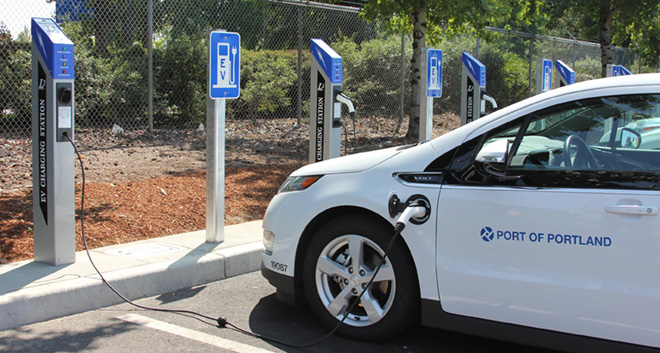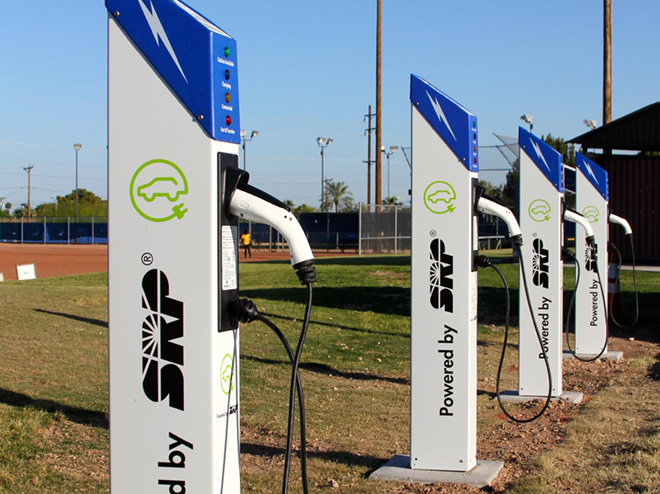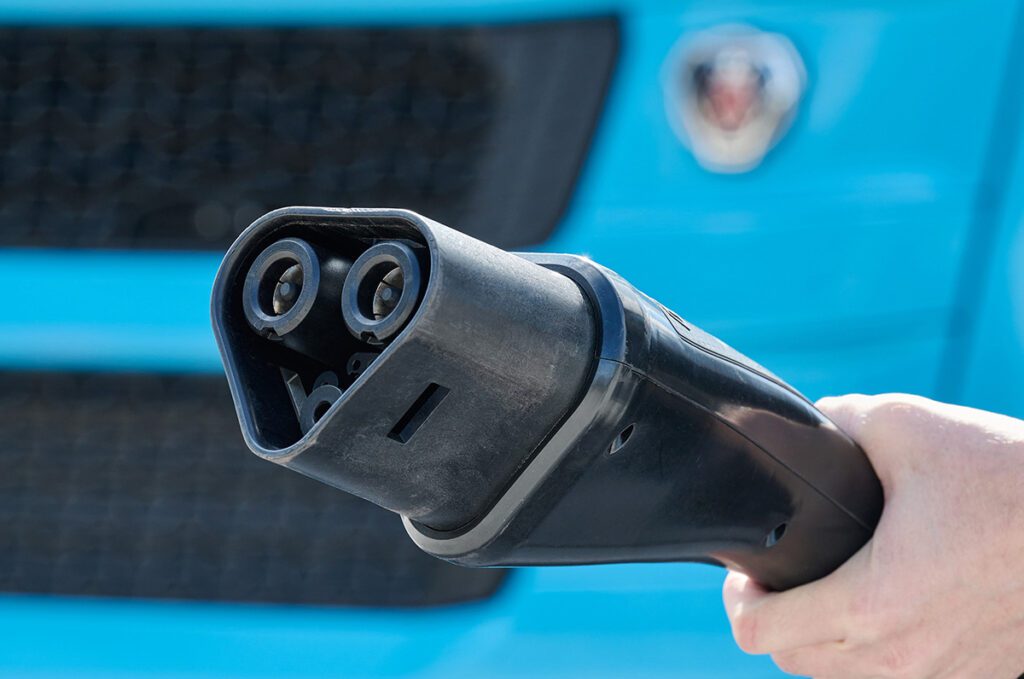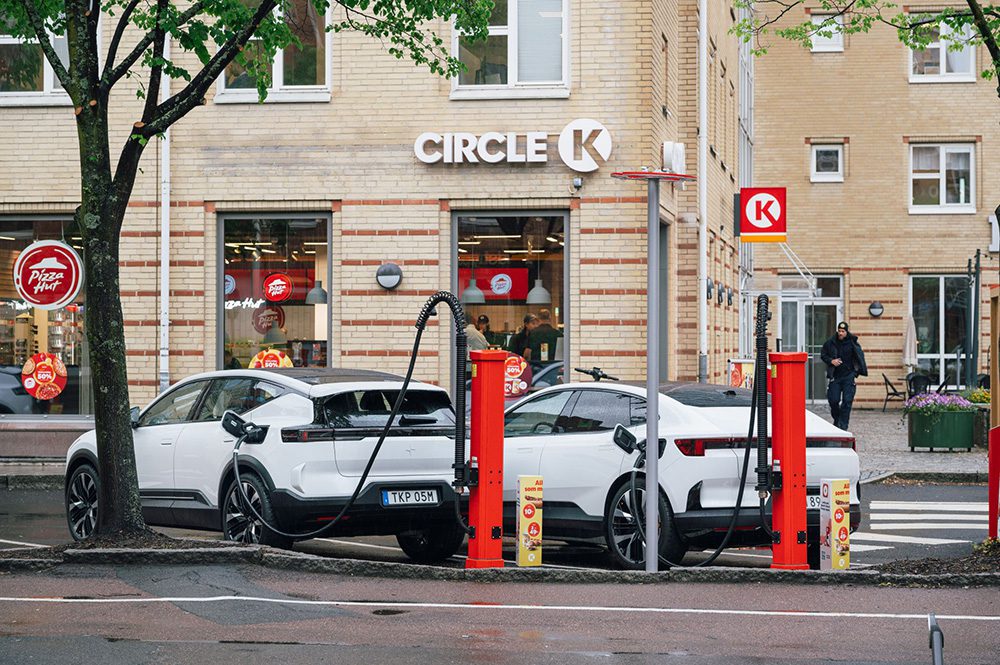Everyone who watches the sketch comedy show Portlandia knows that the dream of the 90s is alive in Portland. Our dream of the 90s was vehicle electrification, and we hoped the GM EV-1 would kick-start the trend more than a decade before the Tesla Roadster actually did it.
Well, the vehicle electrification dream is alive in Portland, and when you go there, you can witness it as soon as you step off the plane. As of August, Portland International Airport (PDX) sports 42 Telefonix L1 PowerPost Level 1 charging stations, all of which are free to use for airport employees and visitors.
If you’re thinking to yourself, “Wait a minute. Level 1? Free charging? Those really are concepts from the 90s,” then you’re thinking along on the lines of LEED certification and most government incentive programs, which don’t have a lot of regard for L1 charging. However, Bill Williams, Business Development Manager at Telefonix, EVSE division, sees a reckoning on the horizon for public Level 2 charging.
The level playing field
Williams, who has been beating the drum for L1 workplace charging at Telefonix for about two years, talks frequently about the progression of EVSE coming to a fork in the road, where in one direction you have public charging moving toward paid DC fast charging, and in the other you have free L1 for “long-dwell” locations, such as workplaces, airports and hotels. Even though L2 public stations are extremely common at the moment, a growing mound of evidence indicates that L1 charging may be more suitable for many applications that encourage EV adoption.
A large survey from March 2015 by PlugInsights found that only 5-7% of total monthly EV charging was happening at either paid or free public L2 stations. The survey also showed that 58% of public L2 station users have been unable to charge at some point because the equipment was out of service. Often the service shutdown was due to the networked payment equipment. PlugInsights’ conclusions at the end of the document included a recommendation for public fast charging instead of public L2.
Another 2015 study from the Southwest Energy Efficiency Project (SWEEP) showed that public L2 charging in Boulder, Colorado – a region with an EV adoption rate second only to California – was greatly underutilized. The report recommended shifting public charging to DC quick charging and offering L1 for free workplace charging.

“Those findings have also been corroborated by cities like Copenhagen,” Williams said, “where significant EV adoption and charging infrastructure development efforts have found that home and workplace charging have by far the biggest impact on EV adoption and use.”
The SWEEP study’s recommendations sound like they could have come straight from Williams’ mouth. He’s on a crusade to supply the $1,495 MSRP Telefonix L1 PowerPost charging station to workplaces – one hospital, school or office block at a time. The L1 PowerPost charger can replenish 20 miles of EV range – about the average length of a commute – in about four hours for less than $1 at today’s average rates. That makes for an employee perk that’s on par with free coffee, and the low-power charging likely won’t boost electricity rates to levels that would incur demand charges from the utility. While Telefonix can supply a metering solution for its PowerPost units, by making the charging free to employees the employer saves on monthly metering fees and keeps the cost lower.

“A lot of employers get sticker shock from quotes by the larger networks, who say the chargers are as much as $6,000-7,000 each, and the monthly fees are $25-$30 per handle,” Williams said. “They walk away thinking, ‘well if this is charging, then I’m not going to offer it.’ To make this really go mainstream, all the law offices, veterinarians and office buildings out there could easily put in two to four chargers, without all the complicated network stuff, and just pay a one-time fee for the equipment.”

Using the Portland Airport as an example, Williams said that for what PDX paid for 42 L1 PowerPost EVSEs, it could have bought 10 L2 networked stations. However, Williams points out that L2 is overkill in “long-dwell” parking lots like at airports, hotels and workplaces.
“Why use a microwave in a crockpot situation?” Williams asked. “Level 1 is just more bang for your buck. 78% of people commute 20 miles or less. That’s a quarter of an EV’s range; if the battery pack is 24 kWh, that’s replenishing 6 kWh at 10 cents a kWh: 60 cents.”
Free coffee and free juice
At such a low price, more employers may opt to consider charging as a free employee perk, especially if the company has any sustainability goals to reduce workers’ greenhouse gas emissions. Williams understands that businesses giving away free charging could receive complaints from non-EV drivers. “The perception can be that EV drivers are not only getting free electricity, but also premium parking, but one of the things we always educate customers about is that EV drivers are happy with charging anywhere at the facility and the closer to the panel, the less expensive the installation. At the end of the day, you don’t stop offering free coffee to employees because you have a small group that prefers tea,” he quipped.
Williams has been working on vehicle electrification for 20 years, going all the way back to selling the Trans 2 “goofy looking golf carts” in the 90s. He also spent years as an executive for the Zenn (Zero Emission, No Noise) Motor Company in the 2000s, when the Prius hybrid was at full strength.
“About 50% of people buying the Prius at that time owned three or four cars,” he said. “That shows the Prius was going to be dad’s work car, or mom’s car to drive to school. They were buying it specifically for commuting. I think the industry’s trying to shoot themselves in the foot by always talking about the ultimate range EV that we can drive to Vegas. To move EV adoption forward at a quicker pace, I prefer a commuter-targeting sales pitch. I focus on EV adoption 24 hours a day, and the simplest way for us to have the biggest impact is in the workplace. Workplace charging surveys have shown an employee is 20 times more likely to consider a plug-in vehicle if they’re offered charging at work.”
Level 1 misconceptions
There are misconceptions not only about how much it has to cost to provide free workplace charging, but also about how Level 1 charging stations work. Customers aren’t clear about how long they take to charge, and may wonder whether you might as well just use regular power outlets.
For one thing, a particular plug-in car may have its own settings for how fast it charges over L1. For example, Chevy Volts since model year 2013 have defaulted to charging at 8 amps over 120 V, and not everyone knows that the user can set a preference to charge at 12 amps when they’re at home.
“In fact, our Level 1 charges at 16 amps, and we deliver a 1.92 kW charging rate, which is more than a Chevy Volt can take,” Williams said. “Also, the misinformation on how long it takes to charge with L1, that’s starting from a totally depleted battery. People rarely are totally depleted, especially if we’re talking about commuting. We’re just replenishing what it took to get there.”

Williams said he often uses outlets to charge his car, bringing his own cord charger with him to long-term airport parking lots, for example. However, when most people are going to the airport, bringing their own charging cords is not going to fly, and Williams knew just how to explain it to PDX. “Outlets were the first conversation I had with them, and all we had to do was talk about liability,” he said. “When people bring their own cords, there’s a chance of theft or damage, so then you have the liability of a $500 or more cord set. Also, the outlet itself is not designed to be plugged into and unplugged 365 times a year.”
Also, PDX won’t have the safety hazard of cords lying around on the ground, because the Telefonix PowerPost uses the company’s most famous innovation, its patented retractable cord reel. You’ve probably used it before. The company’s cord reel technology first became commercially recognizable on airplane phones about 25 years ago, and it is still found on 80% of long-haul commercial aircraft for things like entertainment system handsets or control units. In fact, the cord reel’s utility is what inspired Telefonix to go into the EVSE business. Their ubiquity means that most EV drivers instinctively understand how to use them, and they automatically retract back into the PowerPost EVSE, keeping the ground around EV charging stations nice and tidy.

Williams said the PDX board was convinced that the cord reel cords were more durable and that L1 PowerPost EVSEs made the most sense for them. However, they didn’t even know there were commercial L1 chargers available until they looked around and saw that airports in Denver, Tampa, Reno, Cincinnati and North Carolina had already adopted Telefonix chargers.
Sensible incentives
Telefonix struggles a bit with the lack of awareness of commercial L1 charging, and Williams’ mission includes spreading that awareness, in part by lobbying for commercial L1 to be added to incentive programs. Currently, L1 charging gets short shrift when it comes to government clean energy programs and LEED green building certification. Williams puts himself in front of influential people to try to change this situation whenever possible. He’s talking to the Green Parking Council, which collaborates with the Green Building Certification Institute – the certification body for LEED green buildings. He’s talking to Robert Graham, the head of the DOE’s EV Everywhere program, which includes the Workplace Charging Challenge that aims to increase the number of US employers offering workplace charging tenfold by 2018. He’s also hopeful about convincing Colorado, which currently doesn’t offer grants for L1, to add it to a workplace charging program that the state is planning.
“I’m barking up the tree,” Williams said. “I’m not going down silent.”
After its L1 PowerPost EVSE launched in May 2013, Telefonix followed up with the L2 PowerPost charging station ($1,795 MSRP) in August 2014. Does Williams’ railing against the logic of L2 argue against the Telefonix L2 product? Not really, because there’s a twist to the L2 PowerPost station. It’s a low-current Level 2 charger designed for outdoor use. It operates at 208-240 V, but only requires a 20-amp circuit, meaning that many facilities can install the stations without upgrading their existing electrical supplies, and there’s less risk of triggering expensive demand charges from the utility. Since the Level 2 chargers will replenish the commute range in half the time, he still recommends the practice of installing these lower priced single-port L2 chargers, rather than dual chargers, between 2-4 parking spaces. This enables the practice of “Moving cords, not cars.” You don’t want a nurse, a teacher, or a high-salaried programmer leaving in the middle of their workday to go move a car when it’s done charging.
Having an L2 product also lets Telefonix customers take advantage of grant money that doesn’t apply to L1 chargers. One of the first L1 PowerPost customers, Denver International Airport, recently came back to Telefonix for an order of 10 L2 PowerPost chargers so that it could use Colorado grant money that doesn’t cover L1 chargers. The airport could have had 12 L1 PowerPost units for the same price, but it wouldn’t have received incentive money to do so.

Leveling up
Airports have been very good to Telefonix so far, but that’s only the tip of the iceberg for workplace and long-term charging. “There are millions of employers out there that could have charging stations overnight if we do this right,” Williams said. “And that’s really what needs to happen.”
In June, the University of Texas MD Anderson Cancer Center in Houston ordered six L2 PowerPost EVSEs to offer free charging to employees. An MD Anderson manager noted that the center’s decision to make workplace charging free helps to promote public air quality, which fits in with its mission to eliminate cancer.

That promotion of public health is just one of the reasons why Williams loves the potential to promote workplace charging within the medical community.
“Seven out of 10 of the highest paid jobs are in the medical profession,” Williams said. “And who’s buying an EV? It’s the upward end of $130K-200K a year households. Hospitals want to promote clean air and healthy living, and they tend to be more interested in new technology.”
Williams said that part of his sales pitch is the publicity that comes at the end of the deal.
“I always talk to customers about putting your green foot forward out there,” Williams said. “Let’s do a ribbon cutting. I always volunteer for that, and my company supports me. If I need to fly to Boise to do a ribbon-cutting, they’re behind it 100%. That’s the fun side of it.”
Perhaps that’s part of what keeps Telefonix EVSE customers coming back for more.
Repeat PowerPost customers have been common, and Williams doesn’t mind doing the piecemeal approach, where a customer orders a few chargers here, and another couple there.
“Every school could have two chargers put in for their teachers who have adopted EVs,” he said, “and my pitch to them is that I’ll come in and speak and turn it into a curriculum. I’m meeting with several school districts about an education program I’ve developed. We’ll teach the kids about that teacher’s commute, how much CO2 was saved from the air and how their renewable energy program is working with the new EV chargers.”
Williams concludes, “If we want EV adoption to increase, workplace charging is the best and most efficient place to focus our efforts. If we expect this sustainable effort to go mainstream, then we need to make it more sustainable and cost-effective.”
This article originally appeared in Charged Issue 23 – January/February 2016. Subscribe now.










































































































